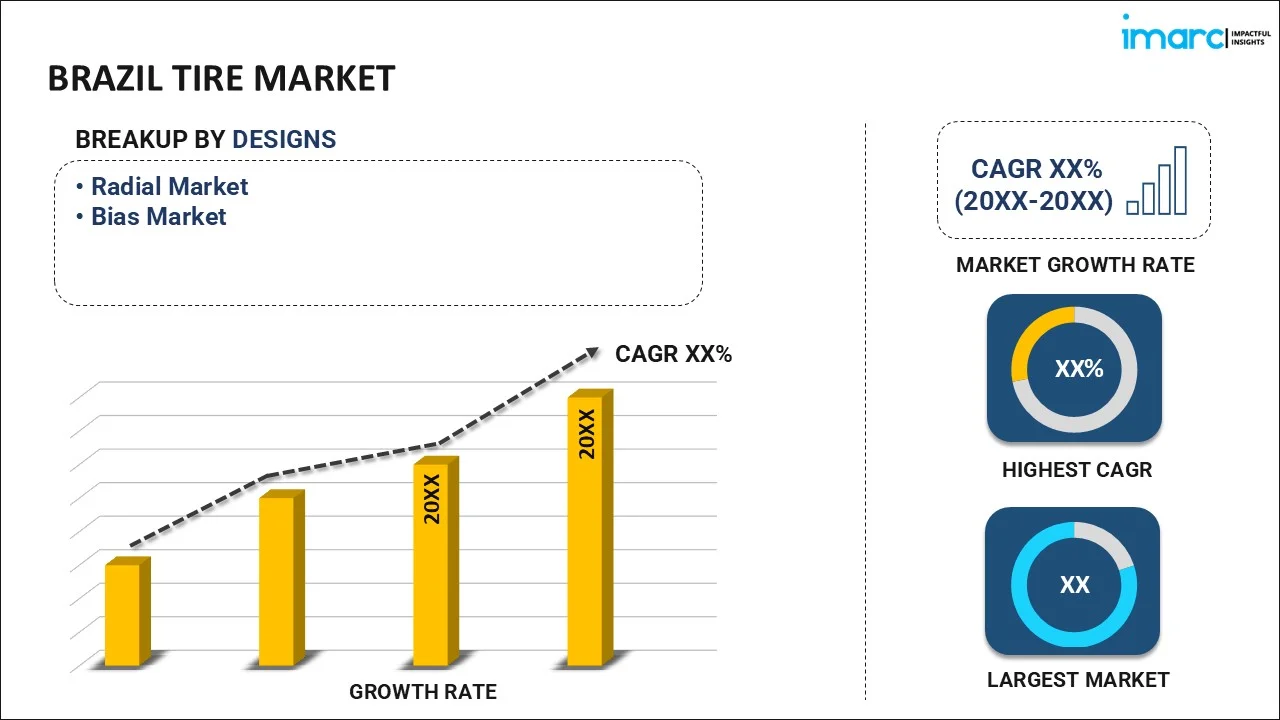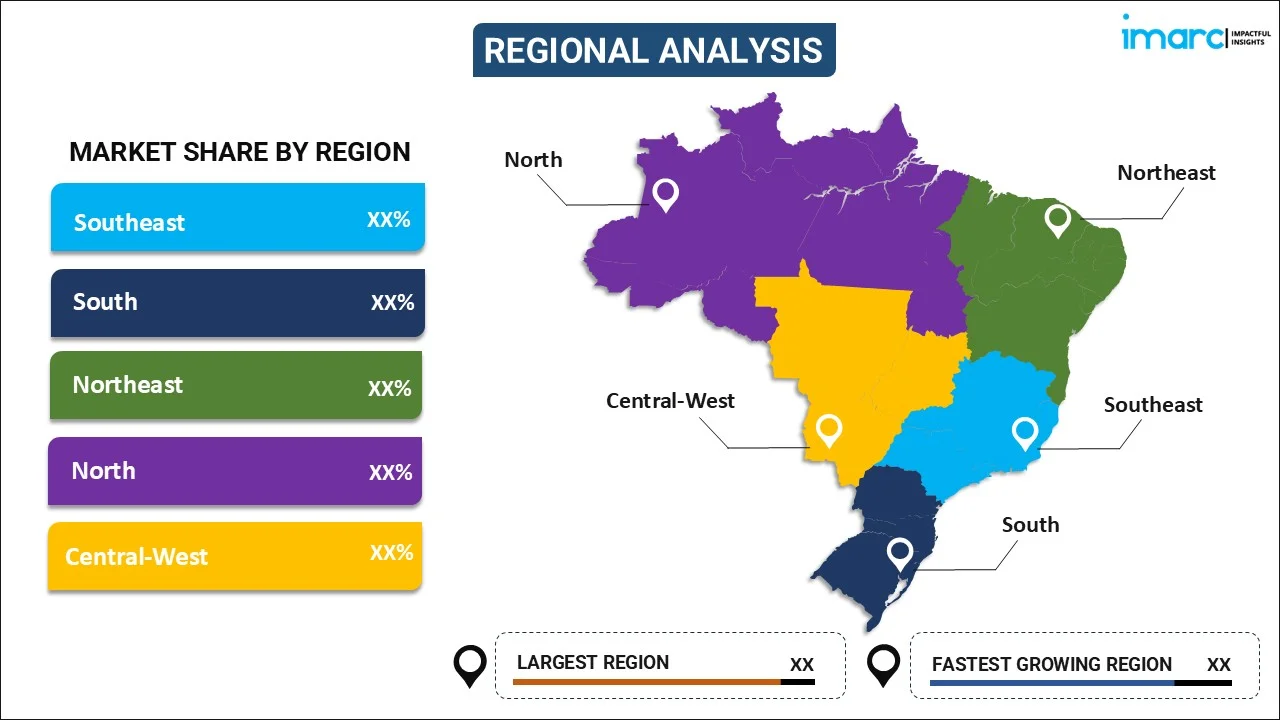
Brazil Tire Market Size, Share, Trends, and Forecast by Design, End Use, Vehicle Type, Distribution Channel, Season, and Region, 2026-2034
Brazil Tire Market Overview:
The Brazil tire market size reached USD 3.3 Billion in 2025. Looking forward, IMARC Group expects the market to reach USD 4.7 Billion by 2034, exhibiting a growth rate (CAGR) of 4.18% during 2026-2034. The market is experiencing significant growth, mainly driven by increasing vehicle production, the rising demand for replacement tires, and the expansion of electric and commercial vehicle segments. Advancements in tire technology, such as eco-friendliness and fuel-efficient designs, also contribute positively to the market growth.
Key Insights:
- Market Size: In 2025, the market was valued at USD 3.3 Billion.
- Projected Growth: The market is expected to grow to USD 4.7 Billion by 2034.
- CAGR: The projected CAGR for the period 2026-2034 is 4.18%.
- Key Segments: The market includes tires for passenger cars, light commercial vehicles, medium and heavy commercial vehicles, and two wheelers.
- Types of Tires: The market covers all season tires, summer tires, and winter tires.
- Factors Driving Growth: The market is influenced by growing car ownership, a developing automotive market, and an expanding middle class in Brazil, leading to increased demand for tires.
Brazil Tire Market Trends:
Rising Demand for Radial Tires
The rising demand for radial tires in Brazil is primarily driven by their superior performance in terms of fuel efficiency and durability. Radial tires are designed with layers of fabric that run perpendicular to the direction of travel, thereby reducing rolling resistance and leading to significant fuel savings for vehicles. This feature is particularly attractive in Brazil, where fluctuating fuel prices make efficiency a priority for both commercial and individual consumers. In addition to fuel efficiency, radial tires offer enhanced durability as compared to traditional bias-ply tires. Their construction allows for better heat dissipation, which reduces wear and tear, thereby extending the lifespan of the tire. As a result, they require less frequent replacement, providing cost benefits to consumers. This combination of economic and performance advantages is contributing to the growing popularity of radial tires in Brazil's expanding automotive tire market. For instance, in March 2023, CEAT Specialty, a division of CEAT Tires, announced a partnership with CNH Industrial to supply agricultural radial tires for Case IH and New Holland tractors in Brazil and Argentina. The agreement follows extensive assessments and tests of CEAT Farmax radials, affirming the quality and reliability of the products. CEAT aims to support farmers in enhancing productivity through this partnership.
Growth of Automotive Industry
The growth of Brazil's automotive industry is significantly boosting tire sales, as increased vehicle production naturally drives the demand for tires. With more cars, trucks, and buses on the road, both the original equipment (OE) and replacement tire markets are seeing a surge in product demand. As consumers purchase new vehicles, manufacturers need more OE tires, while expanding fleets of commercial vehicles, such as trucks and buses require frequent tire replacements due to wear and tear. The Brazil automotive tire market is also being influenced by the used tyre market and the rising popularity of electric vehicles (EVs) and SUVs, which is creating demand for specialized tire designs, further supporting market growth. Furthermore, Brazil’s expanding middle class, improving infrastructure, and increased urbanization are leading to higher vehicle ownership, amplifying the need for Brazil tires across various segments. This trend, coupled with technological innovations in the automotive sector, is expected to sustain the tire demand over the coming years, benefiting both local and international tire manufacturers. According to industry reports, in July 2024, vehicle production in Brazil rose by 16.9% as compared to June, with a total of 246,721 units manufactured, the highest since October 2019. Year-on-year, production increased by 34.8% when compared with July 2023. These statistics are reflective of the significant expansion of the automotive industry in the country, which, in turn, is contributing to the Brazil tyre market growth.
Market Expansion Fueled by Electric and Commercial Vehicles
The Brazil automotive tyre market is significantly influenced by the expansion of both electric and commercial vehicle segments. The push towards sustainable mobility has led to a notable increase in the adoption of electric vehicles (EVs), which require specialized tires to manage the extra weight and instant torque. This has created a new, high-growth niche within the market. Concurrently, the robust growth in the commercial vehicle sector, driven by e-commerce and logistics demands, has amplified the need for durable and high-performance tires for trucks and buses. This is fueling growth in the Brazil off the road tire market as well. Manufacturers and tire service providers are adapting to these trends by developing products and services specifically for these vehicle types, ensuring that the increasing fleet of both EVs and commercial vehicles is well-supported.
Brazil Tire Market Segmentation:
IMARC Group provides an analysis of the key trends in each segment of the market, along with forecasts at the region/country level for 2026-2034. Our report has categorized the market based on design, end use, vehicle type, distribution channel, and season.
Design Insights:

To get more information on this market, Request Sample
- Radial Market
- Bias Market
The report has provided a detailed breakup and analysis of the market based on the design. This includes radial market and bias market.
End Use Insights:
- OEM Market
- Replacement Market
A detailed breakup and analysis of the market based on the end use have also been provided in the report. This includes OEM market and replacement market.
Vehicle Type Insights:
- Passenger Cars
- Light Commercial Vehicles
- Medium and Heavy Commercial Vehicles
- Two Wheelers
- Three Wheelers
- Off-The-Road (OTR)
A detailed breakup and analysis of the market based on the vehicle type have also been provided in the report. This includes passenger cars, light commercial vehicles, medium and heavy commercial vehicles, two wheelers, three wheelers, and off-the-road (OTR).
Distribution Channel Insights:
- Offline
- Online
A detailed breakup and analysis of the market based on the distribution channel have also been provided in the report. This includes offline and online.
Season Insights:
- All Season Tires
- Winter Tires
- Summer Tires
A detailed breakup and analysis of the market based on the season have also been provided in the report. This includes all season tires, winter tires, and summer tires.
Regional Insights:

- Southeast
- South
- Northeast
- North
- Central West
The report has also provided a comprehensive analysis of all the major regional markets, which include Southeast, South, Northeast, North, and Central West
Brazil Tire Market Companies:
The market research report has also provided a comprehensive analysis of the competitive landscape. Competitive analysis such as market structure, key player positioning, top winning strategies, competitive dashboard, and company evaluation quadrant has been covered in the report. Also, detailed profiles of all major companies have been provided.
Brazil Tire Market News:
- In August 2025, the Brazilian government renewed its anti-dumping duties on certain Chinese passenger car tires for up to five more years. This measure, detailed in GECEX Resolution No. 744, aims to protect the domestic tire industry from unfair trade practices.
- In April 2025, Chinese tire manufacturer Linglong Tire announced plans to invest USD 1.19 Billion in a new manufacturing plant in Brazil through a joint venture with local distributor SUNSET S.A. The project, located in Ponta Grossa, is one of the largest Chinese investments in South America's automotive sector.
- In July 2024, Trelleborg Tires, a global leader in agricultural tire and wheel solutions, announced its expansion plan in Brazil by partnering with John Deere. The agreement will see Trelleborg tires being distributed through over 300 John Deere dealerships in Brazil, with a focus on reaching small and medium-sized farmers. This strategic alliance aims to capitalize on John Deere's strong local presence and Trelleborg's innovative product portfolio to gain a larger market share in the country's growing agricultural sector.
- In July 2024, Brazilian manufacturer SpeedMax launched the Energrip tire line, specifically designed for electric vehicles (EVs). With plans to expand, SpeedMax aims to cater to other BYD vehicles in Brazil. The tires are engineered to withstand the additional weight and torque of electric vehicles.
Brazil Tire Market Report Coverage:
| Report Features | Details |
|---|---|
| Base Year of the Analysis | 2025 |
| Historical Period | 2020-2025 |
| Forecast Period | 2026-2034 |
| Units | Billion USD |
| Scope of the Report |
Exploration of Historical Trends and Market Outlook, Industry Catalysts and Challenges, Segment-Wise Historical and Future Market Assessment:
|
| Design Covered | Radial Market, Bias Market |
| End Uses Covered | OEM Market, Replacement Market |
| Vehicle Types Covered | Passenger Cars, Light Commercial Vehicles, Medium and Heavy Commercial Vehicles, Two Wheelers, Three Wheelers, Off-The-Road (OTR) |
| Distribution Channels Covered | Offline , Online |
| Seasons Covered | All Season Tires, Winter Tires, Summer Tires |
| Regions Covered | Southeast, South, Northeast , North, Central West |
| Customization Scope | 10% Free Customization |
| Post-Sale Analyst Support | 10-12 Weeks |
| Delivery Format | PDF and Excel through Email (We can also provide the editable version of the report in PPT/Word format on special request) |
Key Benefits for Stakeholders:
- IMARC’s industry report offers a comprehensive quantitative analysis of various market segments, historical and current market trends, market forecasts, and dynamics of the Brazil tire market from 2020-2034.
- The research report provides the latest information on the market drivers, challenges, and opportunities in the Brazil tire market.
- Porter's five forces analysis assist stakeholders in assessing the impact of new entrants, competitive rivalry, supplier power, buyer power, and the threat of substitution. It helps stakeholders to analyze the level of competition within the Brazil tire industry and its attractiveness.
- Competitive landscape allows stakeholders to understand their competitive environment and provides an insight into the current positions of key players in the market.
Key Questions Answered in This Report
The Brazil tire market was valued at USD 3.3 Billion in 2025.
The Brazil tire market is projected to exhibit a CAGR of 4.18% during 2026-2034, reaching USD 4.7 Billion by 2034.
Key factors include increasing vehicle production, the growing demand for replacement tires, and the expansion of electric and commercial vehicle segments. Advancements in tire technology and a growing middle class also positively influence the market.
Brazilian tire factories produce various types of tires, including passenger car tires, commercial vehicle tires for trucks and buses, and off the road (OTR) tires for agricultural and mining machinery. They also manufacture tires for motorcycles and bicycles.
Need more help?
- Speak to our experienced analysts for insights on the current market scenarios.
- Include additional segments and countries to customize the report as per your requirement.
- Gain an unparalleled competitive advantage in your domain by understanding how to utilize the report and positively impacting your operations and revenue.
- For further assistance, please connect with our analysts.
 Request Customization
Request Customization
 Speak to an Analyst
Speak to an Analyst
 Request Brochure
Request Brochure
 Inquire Before Buying
Inquire Before Buying




.webp)




.webp)












